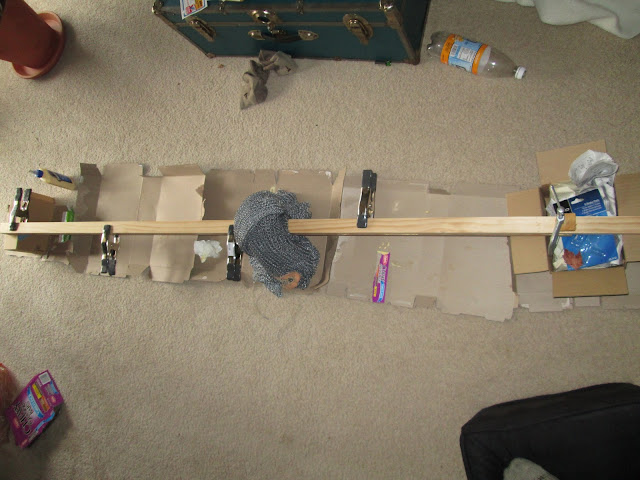I used red oak for the belly of the bow and white pine for the back. I laminated them together:
I surely could have used more clamps, but I didn't want to spend an arm and a leg on this project (more on that later). I weighed it down in the middle with my hauberk (15 pounds) to give a little bit of reflex.
Here it is glued up. You can see how there is a little bit of flex towards the pine side (the left).
After it was glued, I marked out the rough shape and cut it out with a handsaw (oak is not easy to cut). Take note: I started this project on 4/20, and only finished the rough cutting about ten days later. Then came tillering. This is as far as the bow would bend at 50 pounds (my target weight) before any shaping.
The first day of shaving it down did not make a huge difference. I bought a Surform tool to help things along (which is amazing, by the way), and things got a little quicker. In the course of this project, I spent about $12 on wood for the bow itself, and probably about $40 on tools. It's an investment, though.
This is on 5/1:
5/3 at 9:15 am. Notice I have gone from a leather-tipped long string to a string that is close to the actual length of the finished string.
2:15 pm. I have gotten the tips of the bow to meet the brace height.
5/4. I tightened the string to brace height (the middle of the string about 6" from the bow).
By 11:08 am, I got the bow to full draw at 50 pounds.
After all the heavy bending, the bow did take some set towards the oak side, but as you can see below, it only took about one inch. Given that the bow started reflexed in the opposite direction, this amount of set is not too severe.
The bow is almost complete. I need to add horn or antler nocks on the ends and make it a bowstring. I've already sanded it nice and smooth and given it a coat of beeswax and tallow.
Once I get it finished and strung (and make or find some arrows), I'll take some pictures of it in use.










No comments:
Post a Comment